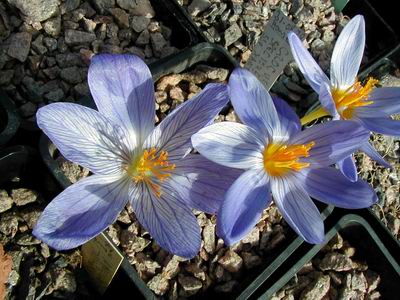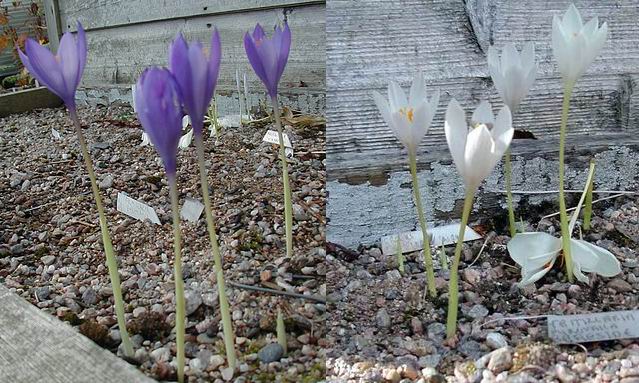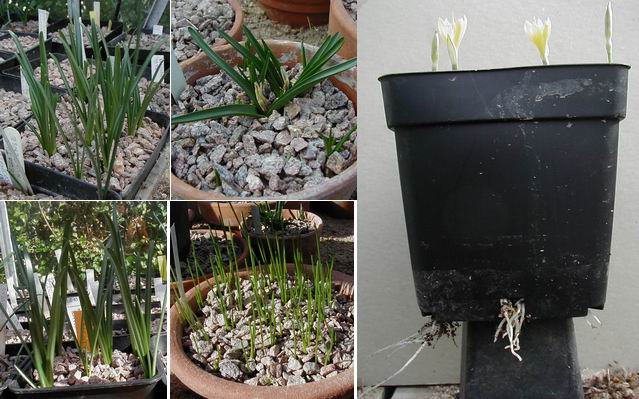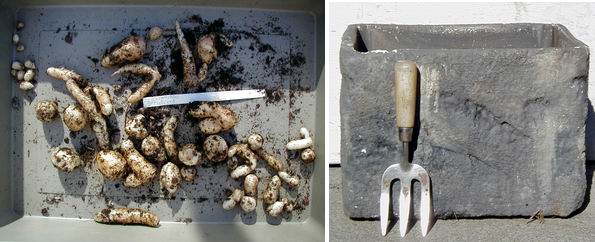 |
SRGC Bulb Log Diary |
| Home Recommend This Site To A Friend |
|
BULB LOG 39 23th September 2003

Crocus speciosus & ssp xantholaimos In a recent log I showed a picture of Crocus speciosus ssp xantholaimos, now I thought that I would show the difference between Crocus speciosus and the subspecies xantholaimos. The flower on the left (which I picked in the garden and stuck in the pot for comparison) is Crocus speciosus, note that it has a white throat and the two flowers on the right with yellow throats are ssp xantholaimos. The throat colour is the diagnostic feature, the other markings do not matter. 
Crocus kotschyanus & niveus Crocuses are popping up every day in both the bulb house and the garden, above is Crocus kotschyanus on the left and C. niveus on the right. It is interesting to note that pots of seed raised bulbs will not necessarily all flower at the same time some may have an odd flower in over a period of several weeks. If you want a display of lots in flower at the same time, (for the show benches perhaps) it is best to select a single clone and build it up to fill a pot. 
Crocus nudiflorus & albus On the left is the most common form of Crocus nudiflorus that goes around, it is a dark purple coloured flower on a fairly extended tube, it is at its best growing through a dwarf shrub or mat forming plant which help support it and make it look less gangly. This type of photograph is driving me crazy with my digital camera as the auto focus does not always look at what I am wanting to be in focus. For this reason I am looking into getting a new one that offers me a manual focus override ( I must say that is the only fault of an other wise excellent wee camera). Back to the other crocus, on the right is Crocus nudiflorus albus, sometimes there is just a hint of pink/purple in the petals when they first open but this quickly fades to white. It multiplies by stolons just like most other forms of C. nudiflorus, it has also set seed and we have three year old seedlings that I hope will flower next year it will be interesting to see what they are like. This white form has been given a cultivar name, which I cannot remember just now, I will search it out and let you know in a future log, maybe some one can tell me through the bulb log feed back and save me trawling through the Journals. 
Colchicum sp. This is a fine colchicum which I have failed to get a name for since I first flowered it in 1989 (it came to us via Harold Esslemont and it had no label when he gave it to us but he thought it had come from Greece). Even the experts that have seen it in flower failed to provide me a name for it. Any ideas ? It does not like it too wet and it is one of the bulbs that after the first two storms (the second one is coming soon) I do not water into the pot again, just keeping the plunge moist provides it with enough water. I nearly lost it a few times by watering it like the other bulbs, this resulted in the bulbs dying from rot. This is a warning that although the basic regime of watering that I use suits 90 percent of the bulbs we grow there are a few that like it a bit drier and a few a bit wetter, you just have to observe and react to how the plant is responding. 
September growth Talking of watering since the September storm many pots have leaves appearing indicating that roots are also extending (picture right) and it is important to keep them watered. I like the pots to nearly dry out before I water them again then, when I apply water, I flood the pot. This allows air to penetrate into the compost and to the roots, for the plant needs air at the roots as much as it needs water - a lack of either will damage or kill the plant but a lack of air will kill it quicker. In this unseasonably hot weather it is worth checking to see that the sand beds/plunges have not dried out completely and apply a little water if they have. 
Sternbergia sicula This is a good flowering form of Sternbergia sicula that I got a number of years ago from Broadleigh Gardens and it flowers well for us every year even in the cold north. 
Cyclamen cilicium Cyclamen cilicium is now coming out in the garden and this is also another example of that auto focus problem that annoys me. 
Codonopsis grey wilsoii tubers These are the tubers of Codonopsis grey wilsoii which vary in shape from round to branched sausage shapes (that is a technical term). We now grow them in deep polystyrene boxes in a humus rich mixture which we can keep nice and moist (they like this) the box is placed at the bottom of a shrub or clematis for them to climb up so they can get their flowers into the sunshine (they like this too). I will leave you this week with a picture taken in July of the codonopsis in flower. 
Codonopsis grey wilsoii ^ back to the top ^ |